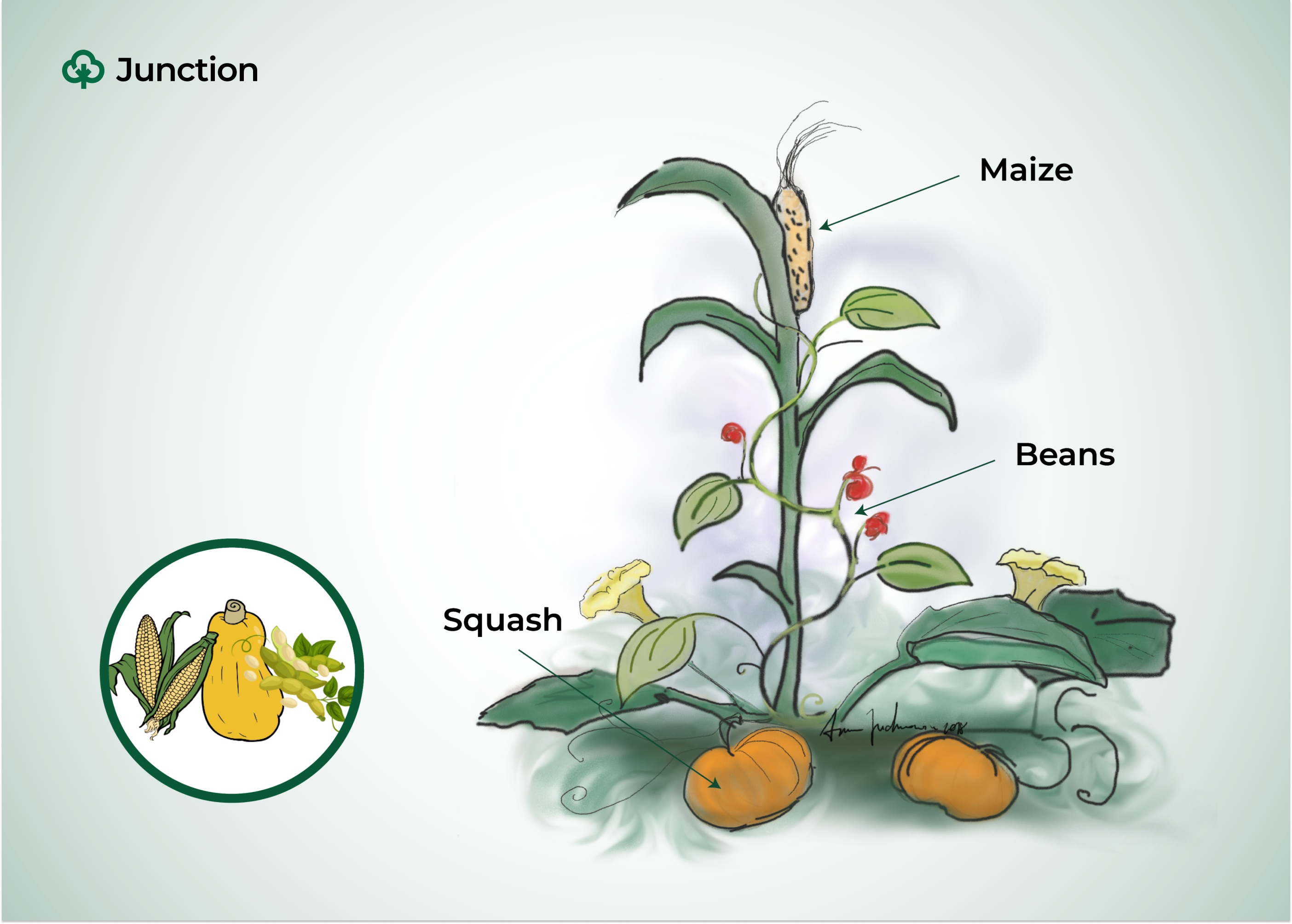An age-old farming method could solve many of the challenges farmers face today including poor soil, unpredictable weather, and the rising cost of fertilisers.
The Three Sisters Technique, a method perfected by Native American farmers centuries ago, is still helping growers achieve better yields while working in harmony with nature. The best part is that it can work just as well for Nigerian farmers, no matter the region.
Origin of the Three Sisters
The Three Sisters method originated with the Iroquois, a group of Native American tribes in North America. It was a traditional way of farming that involved planting three crops corn, beans, and squash together in a system designed to help them thrive. This practice has been passed down for generations and is still used today because of its many benefits to both the plants and the soil.
In Native American culture, the Three Sisters were seen as a gift from the earth, each contributing to the success of the others. The idea was not just about growing crops; it was about creating a balanced system where each plant had a role to play in helping the others grow. This ancient wisdom offers a lot of insight for modern-day farmers, especially those in Nigeria.
What is the Three Sisters method?
The Three Sisters method is all about companion planting and growing crops that support each other in a mutual relationship. In this method:
- Corn (Maize) acts as the tall stalk that supports the climb of the beans.
- Beans are nitrogen-fixing plants, which means they help add important nutrients back into the soil, especially nitrogen, which is critical for plant growth.
- Squash grows low to the ground, creating a natural weed barrier by spreading its large leaves over the soil. These leaves also help retain moisture and protect the soil from erosion.
By planting these three crops together, farmers can make better use of their land, increase crop yields, and improve the overall health of the soil.
Benefits
The Three Sisters method offers several key advantages that can help Nigerian farmers improve their farming practices. These include:
- Improved Soil Fertility: The beans, as nitrogen-fixing plants, naturally enrich the soil. This reduces the need for artificial fertilisers, which can be expensive and harmful to the environment.
- Increased Crop Yield: When plants grow together in a symbiotic relationship, they make the most of available resources like space, sunlight, and water, leading to higher yields.
- Reduced Weed Growth: The squash’s large leaves cover the soil and block sunlight from reaching weeds, reducing the need for chemical herbicides and manual weeding.
- Natural Pest Control: The diversity of plants can confuse and repel pests, which reduces the need for chemical pesticides. Corn, beans, and squash each have unique properties that keep pests at bay.
- Sustainability: The method is highly sustainable, reducing reliance on chemicals and artificial inputs, which is especially important for smallholder farmers who may not have access to expensive inputs.
How Nigerian Farmers Can Implement the Three Sisters Method
Nigerian farmers, especially those in small-scale or subsistence farming, can greatly benefit from adopting the Three Sisters method. Here’s a step-by-step guide on how to implement it:
- Choose the Right Varieties of Crops:
- Corn (Maize): Choose a variety of corn that grows well in your region, such as the Local Yellow Maize or Hybrid Maize.
- Beans: Varieties like Cowpea or Soybean work well with the Three Sisters method.
- Squash: Pumpkin or Zucchini are great options that can spread out and cover the ground effectively.
- Prepare the Soil:
- Start by clearing the field and tilling the soil to ensure it’s soft and well-aerated.
- Incorporate organic matter like compost to boost soil fertility.
- Planting the Crops:
- Corn: Plant the corn in small mounds, leaving enough space between each mound to allow the plants to grow tall.
- Beans: Once the corn is about a foot tall, plant beans around the base of the corn stalks. The beans will climb up the corn as they grow.
- Squash: Plant squash seeds around the edges of the corn and beans, allowing them to spread out and cover the ground.
- Watering and Maintenance:
- Ensure the plants receive consistent water, especially during dry periods.
- Use mulch around the plants to retain moisture and keep the soil cool.
- Harvesting:
- Harvest the corn when the kernels are fully mature.
- Harvest the beans once the pods are dry.
- Pick squash when they are fully grown and firm.
Things to consider
While the Three Sisters method has many benefits, there are a few factors to keep in mind:
- Spacing: The crops need enough space to grow, so it’s important to plant them at the right distances. Too little space may cause overcrowding, while too much space could reduce the efficiency of the system.
- Timing of Planting: Ensure the planting of corn is done early enough so that the beans and squash have enough time to grow together.
- Environmental Conditions: The Three Sisters method works best in areas with a moderate climate and good rainfall. In dry regions, consider watering the crops regularly.
Potential disadvantages
While the Three Sisters method offers many advantages, there are a few potential challenges:
- Space Requirements: The system requires sufficient space for the three crops to grow. Farmers with limited land might struggle to implement this method effectively.
- Pests and Diseases: While the method helps with pest control, some pests or diseases might still affect the crops, requiring additional management.
- Crop Competition: If not managed properly, the crops may compete for resources, such as water and nutrients.
FAQ section
- Can I use this method for all crops?
No, the Three Sisters method is best suited for crops like corn, beans, and squash that complement each other. Other crops might not work well together in the same way. - What if I don’t have enough space?
If you have limited space, try using raised beds or containers. You can also consider growing just two of the Three Sisters crops together (corn and beans or beans and squash) to save space. - How can I manage pests naturally?
You can plant other companion plants like marigolds or garlic around your Three Sisters to help repel pests naturally. You can also practice crop rotation each year to reduce pest buildup. - Can I grow Three Sisters in the rainy season?
Yes, the rainy season is an ideal time to grow the Three Sisters, as long as the soil doesn’t become waterlogged. Proper drainage is important to prevent root rot.



